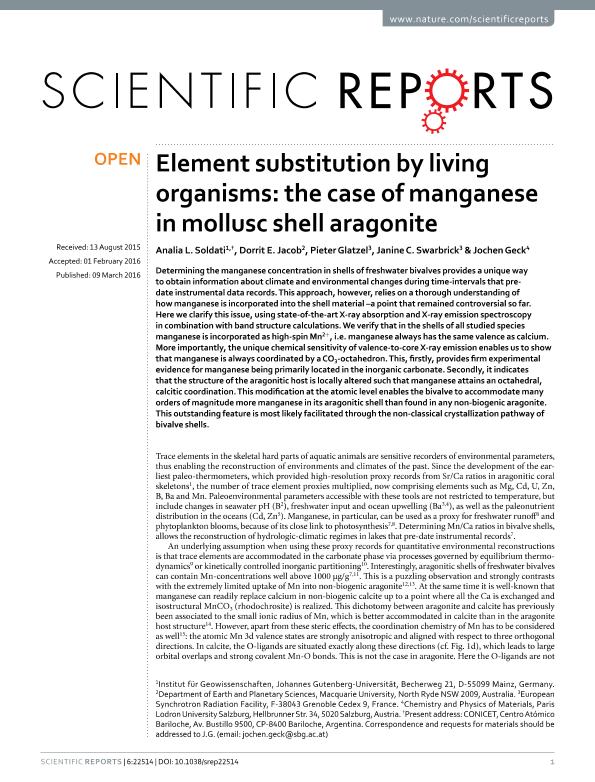Mostrar el registro sencillo del ítem
dc.contributor.author
Soldati, Analía Leticia

dc.contributor.author
Jacob, Dorrit E.
dc.contributor.author
Glatzel, Pieter
dc.contributor.author
Swarbrick, Janine C.
dc.contributor.author
Geck, Jochen
dc.date.available
2018-09-19T16:38:12Z
dc.date.issued
2016-03
dc.identifier.citation
Soldati, Analía Leticia; Jacob, Dorrit E.; Glatzel, Pieter; Swarbrick, Janine C.; Geck, Jochen; Element substitution by living organisms: The case of manganese in mollusc shell aragonite; Nature Publishing Group; Scientific Reports; 6; 3-2016; 22514-22524
dc.identifier.issn
2045-2322
dc.identifier.uri
http://hdl.handle.net/11336/60231
dc.description.abstract
Determining the manganese concentration in shells of freshwater bivalves provides a unique way to obtain information about climate and environmental changes during time-intervals that pre-date instrumental data records. This approach, however, relies on a thorough understanding of how manganese is incorporated into the shell material-a point that remained controversial so far. Here we clarify this issue, using state-of-the-art X-ray absorption and X-ray emission spectroscopy in combination with band structure calculations. We verify that in the shells of all studied species manganese is incorporated as high-spin Mn 2+, i.e. manganese always has the same valence as calcium. More importantly, the unique chemical sensitivity of valence-to-core X-ray emission enables us to show that manganese is always coordinated by a CO 3-octahedron. This, firstly, provides firm experimental evidence for manganese being primarily located in the inorganic carbonate. Secondly, it indicates that the structure of the aragonitic host is locally altered such that manganese attains an octahedral, calcitic coordination. This modification at the atomic level enables the bivalve to accommodate many orders of magnitude more manganese in its aragonitic shell than found in any non-biogenic aragonite. This outstanding feature is most likely facilitated through the non-classical crystallization pathway of bivalve shells.
dc.format
application/pdf
dc.language.iso
eng
dc.publisher
Nature Publishing Group
dc.rights
info:eu-repo/semantics/openAccess
dc.rights.uri
https://creativecommons.org/licenses/by-nc-sa/2.5/ar/
dc.subject
Paleoclimate
dc.subject
Trace Elements
dc.subject
Xanes
dc.subject
Microscopy
dc.subject.classification
Meteorología y Ciencias Atmosféricas

dc.subject.classification
Ciencias de la Tierra y relacionadas con el Medio Ambiente

dc.subject.classification
CIENCIAS NATURALES Y EXACTAS

dc.title
Element substitution by living organisms: The case of manganese in mollusc shell aragonite
dc.type
info:eu-repo/semantics/article
dc.type
info:ar-repo/semantics/artículo
dc.type
info:eu-repo/semantics/publishedVersion
dc.date.updated
2018-09-14T14:02:50Z
dc.journal.volume
6
dc.journal.pagination
22514-22524
dc.journal.pais
Reino Unido

dc.journal.ciudad
Londres
dc.description.fil
Fil: Soldati, Analía Leticia. Consejo Nacional de Investigaciones Científicas y Técnicas; Argentina. Johannes Gutenberg-Universität; Alemania. Comisión Nacional de Energía Atómica. Centro Atómico Bariloche; Argentina
dc.description.fil
Fil: Jacob, Dorrit E.. Macquarie University; Australia
dc.description.fil
Fil: Glatzel, Pieter. European Synchrotron Radiation Facility; Francia
dc.description.fil
Fil: Swarbrick, Janine C.. European Synchrotron Radiation Facility; Francia
dc.description.fil
Fil: Geck, Jochen. Paris Lodron University Salzburg; Austria
dc.journal.title
Scientific Reports
dc.relation.alternativeid
info:eu-repo/semantics/altIdentifier/doi/https://dx.doi.org/10.1038/srep22514
dc.relation.alternativeid
info:eu-repo/semantics/altIdentifier/url/https://www.nature.com/articles/srep22514
Archivos asociados
